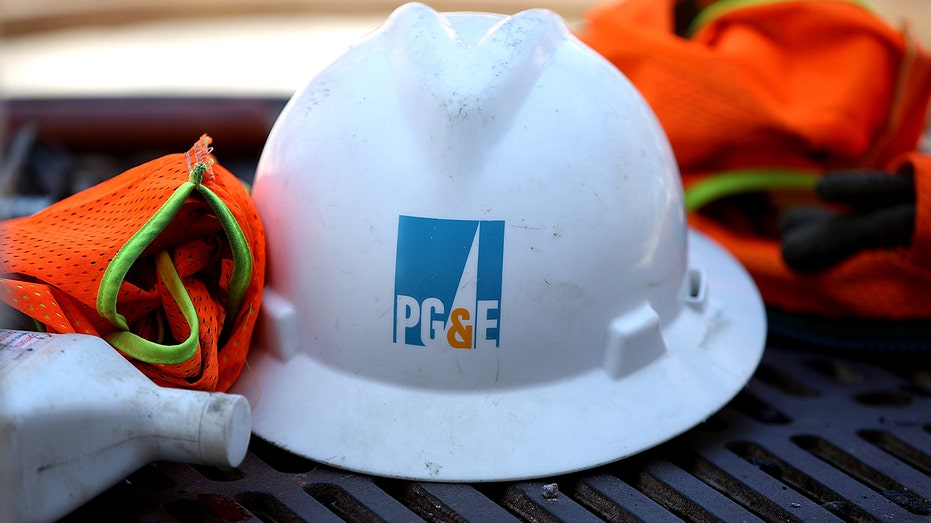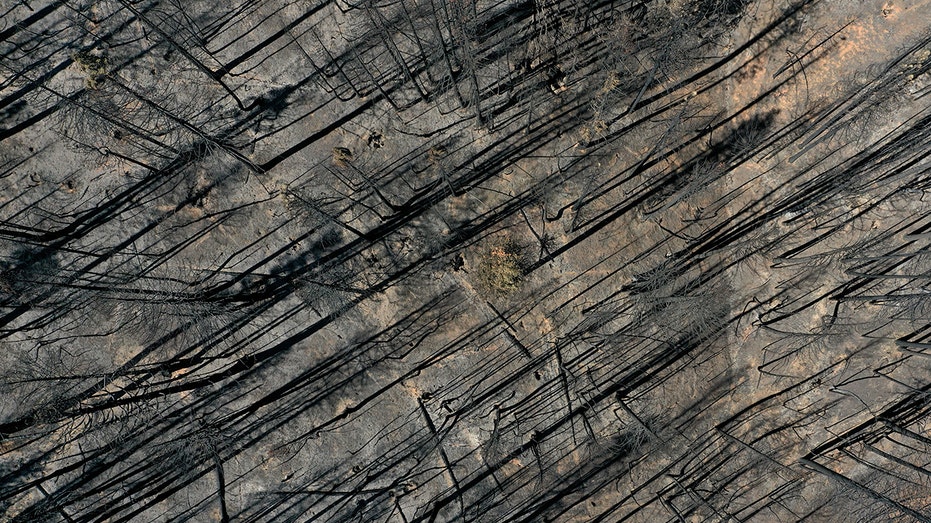Fixing PG&E is one of America's most difficult CEO jobs
Patti Pope surprised PG&E board with $20B plan to bury power lines like one that sparked Chico wildfire
As a California wildfire was exploding in July to become the state’s second-largest ever, Patti Poppe made an executive decision.
The chief executive of PG&E Corp. PCG -0.09% traveled to the town of Chico, in fire-ravaged Butte County, and declared that the utility would spend as much as $20 billion to bury 10,000 miles of power lines like the one that had likely sparked the fire burning out of control just miles away.
The decision left PG&E’s board of directors reeling, according to people familiar with the matter: The company had scarcely fleshed out the details of the proposal, or how to pay for it. Ms. Poppe had surprised the board the night before with her plan to publicize it anyway.

The Pacific Gas and Electric logo is displayed on a hard hat at a work site in 2014 in San Francisco. (Justin Sullivan/Getty Images / Getty Images)
CALIFORNIA CITY CONSIDERS OFFERING HIGHEST MINIMUM WAGE IN THE NATION: ‘CAN’T SURVIVE IT’
The announcement amounted to a Herculean promise to substantially reduce wildfire risk by safeguarding electric lines from making contact with trees. No U.S. utility has ever attempted such a feat, in part because of cost and engineering hurdles. PG&E itself had earlier called undergrounding, as the practice is known, prohibitively expensive.
Ms. Poppe was now pledging publicly that PG&E would find a way to make it happen.
"I could not go up to Chico and look those people in the eye and apologize and not tell them what we’re doing," Ms. Poppe later said in an interview.
| Ticker | Security | Last | Change | Change % |
|---|---|---|---|---|
| PCG | PG&E CORP. | 15.70 | -0.15 | -0.95% |
When Ms. Poppe, a 52-year-old former Michigan utility executive, took the helm at PG&E in January, she assumed one of the most difficult CEO jobs in the country. Her challenge: to rapidly overhaul the safety of a sprawling electrical system roughly the size of New England, which continues to ignite major wildfires that have collectively killed more than 100 people in recent years and cost the company the trust of customers, regulators and legislators.
PG&E has cycled through five CEOs during the past 20 years, in which time it filed twice for chapter 11 bankruptcy protection. The company is on federal probation after being convicted on felony charges of violating federal pipeline safety laws. It is one of the few American companies ever to have been convicted of homicide, after pleading guilty to 84 counts of involuntary manslaughter for its role in igniting the 2018 Camp Fire that destroyed the town of Paradise, Calif. A California prosecutor recently filed new involuntary-manslaughter charges against PG&E for its role in sparking a wildfire near the Oregon border that killed four people last year, and the company disclosed this week that it has received a subpoena from federal prosecutors for documents related to the fire that ignited in July.
Meanwhile, California is struggling through a crippling drought that scientists say has been exacerbated by climate change. Tens of millions of trees throughout the company’s Northern California service territory are dead or dying, increasing the risk of rapid fire spread when power lines spark.
Ms. Poppe got a firsthand look at those risks in July, when a Douglas fir tree tipped onto a small power line running through Feather River Canyon in the Sierra Nevada foothills near Chico. A blaze ignited beneath it and exploded to consume nearly a million acres.
Investigators are still probing what became known as the Dixie Fire, but PG&E has acknowledged that it likely started when the tree touched its electric wire. The company has struggled for years to clear its power lines of trees, the most common cause of major fires sparked by its equipment.
The Dixie Fire had started just miles from Paradise, a remote town still rebuilding after the Camp Fire, which was sparked by an aging PG&E transmission line. Upon learning what had happened, Ms. Poppe decided it was time to reveal the plan to underground a swath of the system. A month earlier in June, PG&E had held an internal workshop where employees across multiple divisions brainstormed what it would take to execute such an effort, Ms. Poppe said.

In an aerial view, trees cast shadows in an area burned by the Dixie Fire in September 2021 in Greenville, California. ( Justin Sullivan/Getty Images / Getty Images)
But the company hasn’t yet formulated enough detail to submit a plan to the California Public Utilities Commission, where it is now seeking permission to substantially raise rates—already among the highest in the U.S.—to fund other major safety investments. The announcement also came as a surprise to those within the agency, none of whom had a substantive conversation with PG&E about the plan beforehand, a spokeswoman said.
Mark Toney, executive director of the Utility Reform Network, a consumer advocacy group that scrutinizes PG&E’s requests to raise rates, said he has been impressed by Ms. Poppe’s industry experience and her desire to make a lasting change. But he remains skeptical about the company’s ability to achieve its undergrounding goal in a way that doesn’t put a big financial burden on customers, especially given that it hasn’t hashed out a strategy yet.
"You’re setting a mighty big expectation, and you have no details," Mr. Toney said. "That’s confusing at best."
Several of the company’s directors were upset about Ms. Poppe’s decision to accelerate the undergrounding announcement out of concern that the company won’t be able to deliver on the promise, according to people familiar with the matter. The estimated price tag of up to $20 billion is nearly equal to the company’s current market capitalization.
Across the country, less than 20% of distribution lines—the wires that deliver power to homes and businesses—run underground, largely because burying the wires costs significantly more than stringing them overhead as a result of the need for digging, drilling and more expensive materials. Underground wires can also be more expensive to maintain, given that they are more difficult to access and inspect.
The cost of burying power lines, which involves digging trenches and encasing the wires with insulation and perhaps metal to protect them from subsequent digging, varies widely and depends largely on the density of development around the work site. Industry data indicate it costs between several hundred thousand dollars and several million dollars to bury a single mile of distribution wire, a particularly challenging proposition in urban areas, due to the need for extensive permitting and digging near homes and businesses.
PG&E has been working to bury power lines in Paradise, and the company is learning it can do so for as little as $2 million a mile, down from about $4 million a mile when it started on the work a few years ago—a number that roughly supports the cost estimate for burying 10,000 miles of wire. Ms. Poppe anticipates the company can further cut costs by scaling up the program, which she says will eventually offset the amount the company has to spend on clearing trees and create an opportunity to boost shareholder returns through large capital investments.
"What we’re spending today is too much: $1.4 billion a year in vegetation management alone," Ms. Poppe said. "When I convert that to capital [for] undergrounding, that is a win for customers, and that is a win for investors."
Ms. Poppe acknowledged her decision surprised the board, but said directors knew that the company had started working on the idea. PG&E has since solicited information from 40 engineering and construction firms and shortlisted about 10, Ms. Poppe said. It has also formed an undergrounding council with input from various agencies, environmental groups and others to help formulate the plan.
"I have total support from my board of directors to run the company and to do what is necessary," she said. "They hired me because I’m an experienced utility executive."
Board chairman Robert Flexon, a former power-industry executive, said each of the company’s directors may have their own perspectives on the undergrounding announcement, but that all of them support the idea. He sees the board’s role in the process coming later, as the company fleshes out details related to cost, procurement and planning.
"All of those things will require board scrutiny and board approval," he said. "What we expect from Patti is for [her] to go into a situation like she faced in Chico and be the face of the company and offer solutions."
Since becoming CEO, Ms. Poppe has striven to embody that public ambassador role. She manages her own social media, where she often posts photos and videos of herself with other employees at PG&E work sites. Many include rhetoric about "leading with love," an approach that has surprised many of those she has to work with, including regulators and union members.
Ms. Poppe is an early riser, often waking at 5 a.m. and working out before reading the news and financial analyst notes. Her day officially starts with a meeting with her direct reports in which they review the company’s prior-day performance.
A hundred days into the job, wearing a shirt bearing a white cutout of California with a red heart drawn on it, she recorded a lengthy video in which she explained to employees what it meant to be loved by their leader.
"We’ll put that love mind-set to work and use it to start turning the page on PG&E’s past, change the way we do business and begin writing the next chapter of this iconic company," she said.

In this photo illustration, the Pacific Gas and Electric Company logo is seen on a smartphone and a PC screen. (Illustration by Pavlo Gonchar/SOPA Images/LightRocket via Getty Images / Getty Images)
In the interview, Ms. Poppe said she is trying to rebuild morale within an organization that has been widely villainized in recent years.
"They have been through a lot, and they are resilient," she said of her employees, whom she refers to as her co-workers. "They get up every day to make it safer than it was the day before."
Until moving to Lafayette, Calif., a small city just east of Berkeley, with her husband and her goldendoodle, Chester, Ms. Poppe spent most of her life in Michigan, where she raised twin daughters who now work as engineers. Ms. Poppe started her career as an engineer and plant manager at General Motors Co. and then moved to DTE Energy Co. , a Michigan utility company. She was then hired by a neighboring utility company, CMS Energy Corp. , where she ascended to become CEO in 2016.
For years, Ms. Poppe, who once had a bumper sticker proclaiming her love for coal, denied that climate change was a problem, but said she made an about-face during her time at CMS, after delving more deeply into the science and finding conclusive evidence that humans played a significant role in the phenomenon. As CMS’s CEO, she ended up leading an ambitious effort to speed the company’s shift away from coal to renewable energy and thought deeply about the role of a utility in mitigating climate change. Her next job would require her to consider how a utility should adapt to climate risk.
PG&E’s board of directors tapped Ms. Poppe late last year, several months after former CEO Bill Johnson resigned upon seeing the company through bankruptcy. He had spent just over a year in the role, and was the person who stood in court and pleaded guilty on behalf of the company to 84 counts of involuntary manslaughter in June of 2020.
Ms. Poppe signed a five-year contract, and PG&E’s directors said at the time of her hiring that they hoped she would stay for longer.
Mr. Flexon, who led the search for a new CEO, said that five minutes into an interview with Ms. Poppe, he emailed the chair of the compensation committee to say he didn’t need to interview anyone else. He said her willingness to leave a stable utility like CMS—and to trade the long-term stock awards she had earned there for shares in a risk-laden company—indicated to him that she was willing to stake her legacy on PG&E’s future.
Mr. Flexon said her desire to attempt such a challenging overhaul reminded him of his mind-set in 2011, when he became CEO of Dynegy Inc., a former wholesale power producer in need of a culture shift as it struggled through its own bankruptcy restructuring. Ms. Poppe faces an even larger challenge in reorienting the culture of a company the size of PG&E, he said.
"That’s a big job," Mr. Flexon said. "I’ve been through that, and I didn’t have 25,000 people, two-thirds of which were unionized."
Already, some members of the company’s most prominent union, International Brotherhood of Electrical Workers Local 1245, have bristled at Ms. Poppe’s love-heavy approach. At first, business manager Bob Dean, the union’s top officer, was among them. But he said he changed his perspective upon realizing that she has a tough edge that he sees as critical to making the difficult decisions needed to turn the company around. Internally, she has been working to implement a strict set of principles to improve the safety and efficiency of the company’s processes, he said.
For Mr. Dean, a critical question is how long she stays. The rapid turnover of key executives and personnel has left the company in a lurch over the past several years, he said.
CLICK HERE TO READ MORE ON FOX BUSINESS
"If someone makes a decision on Tuesday, I need to know they are going to be there on Friday," Mr. Dean said.
Ms. Poppe, who has hired a new cohort of executives in recent months, says she is committed to the task of transforming the company. She has lately been attending weekly operating meetings in which executives and other employees gather to discuss performance metrics, including the number of fires sparked by its equipment and progress on a number of wildfire-prevention goals outlined in an annual plan filed with the CPUC.
The company faces an acute challenge. While it has been taking a range of measures to reduce the likelihood of its power lines sparking, the risk is inherent within the system. Live wires can spark on contact with trees and produce arcs of electricity when they get too close to each other or to nearby objects. Such sparks can ignite dry trees and brush—fires that can range from small, easily contained flare-ups to large conflagrations that spread rapidly through parched forests.
CLICK HERE TO GET FOX BUSINESS ON THE GO
At a recent meeting at PG&E’s wildfire-risk command center in San Ramon, Ms. Poppe was quick to offer praise: The ignition rate in certain areas at high risk of wildfire has improved this year as a result of technology the company has deployed on some of its power lines. But she was also quick to question the areas where the company risks falling short of its goals.
High on the ceiling, above a green "Leading with Love" sign, a banner hung:
"CATASTROPHIC WILDFIRES SHALL STOP."
This article first appeared in the Wall Street Journal




















